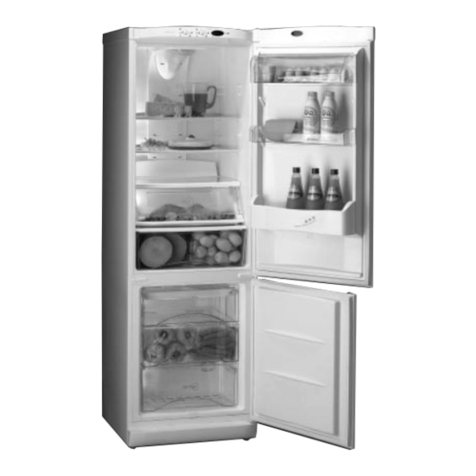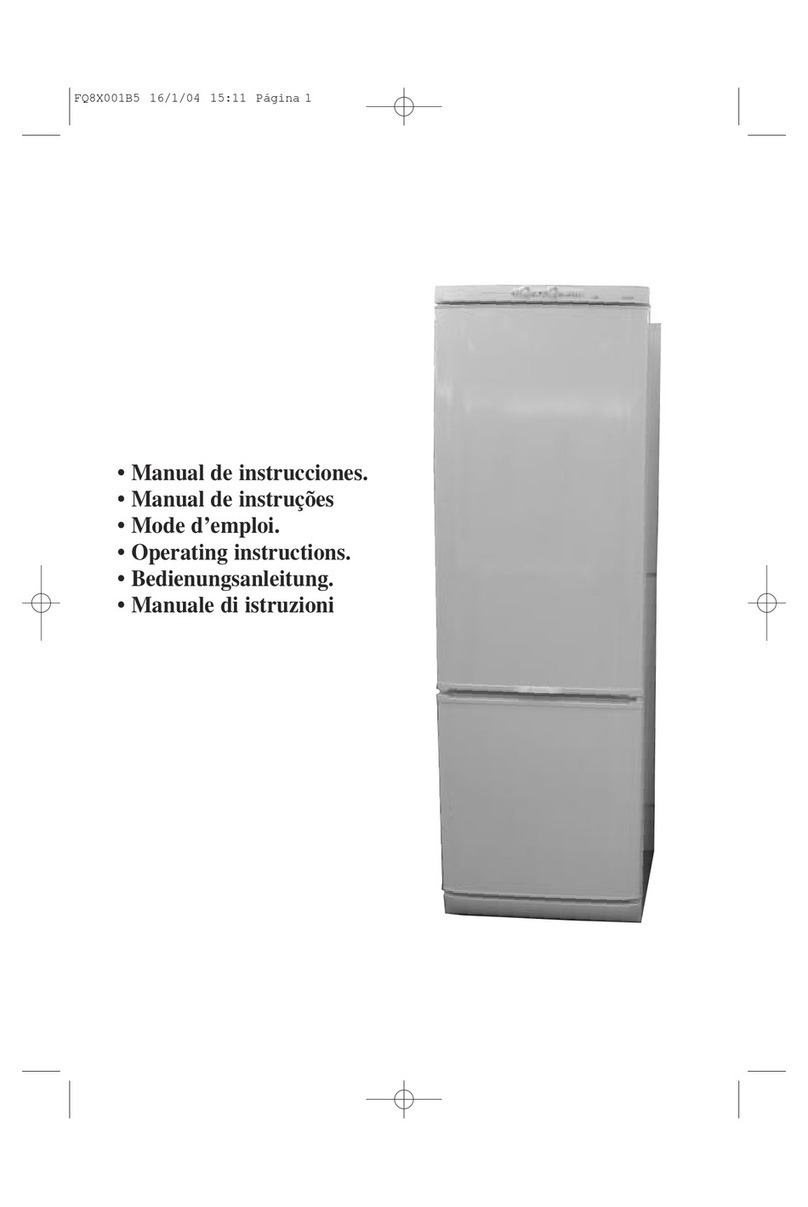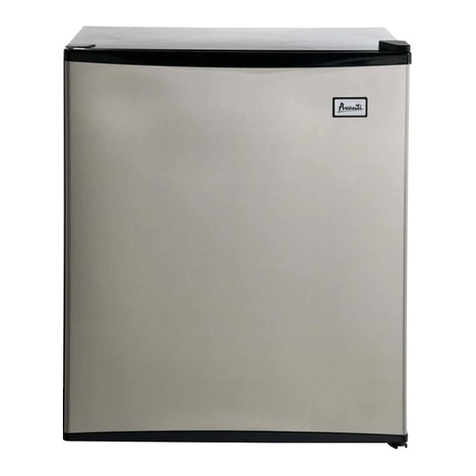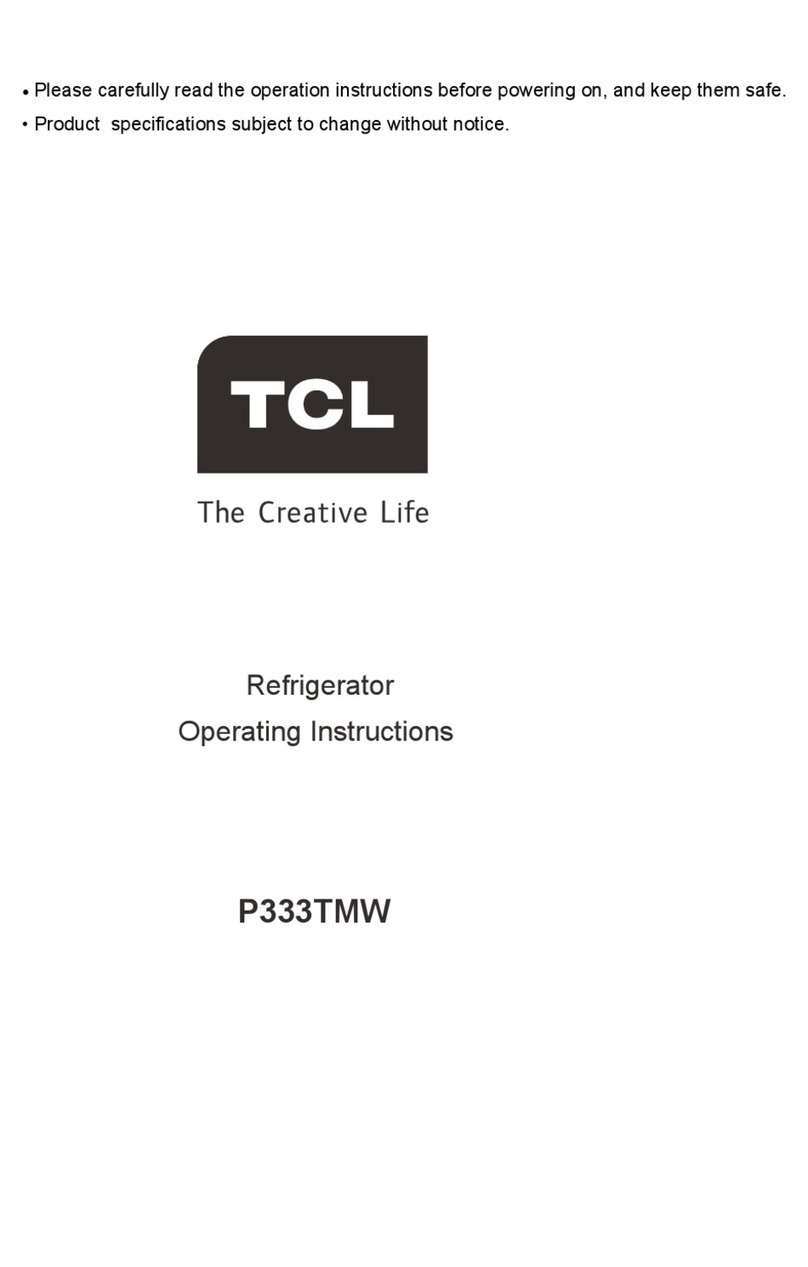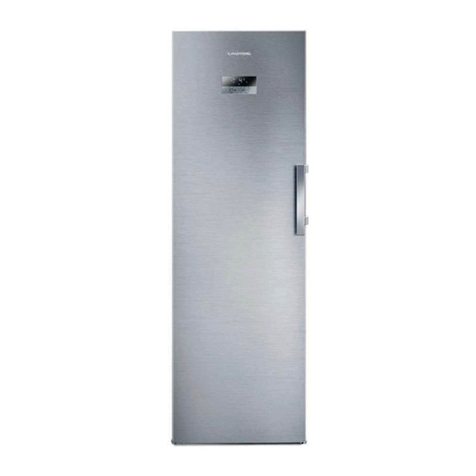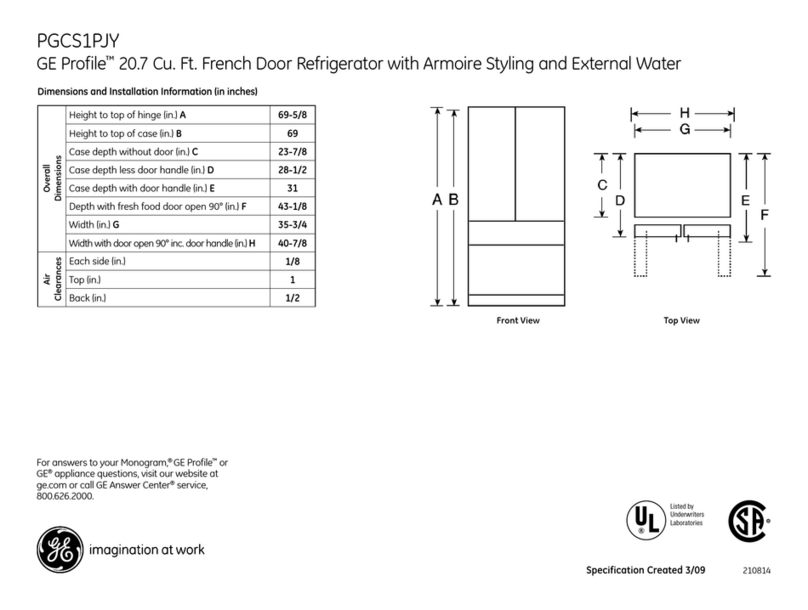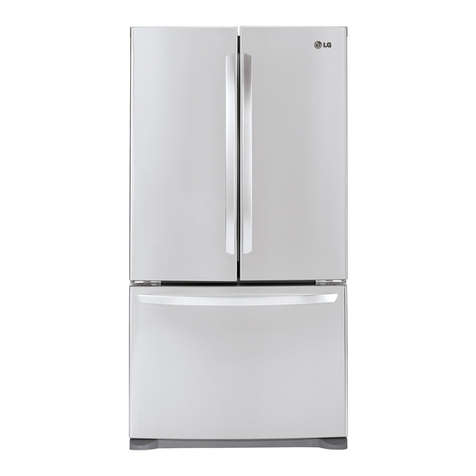Edesa EFS-1823 NF EX User manual

EFS-1823 NF EX
D
Bedienungsanleitung

CONTENTS
1Safety warnings
1.11-2
1.2Meanings of safety warning symbols····················3
1.3Electricity related warnings························3
1.4Warnings for using·························4
1.5Warnings for placement ························4-5
1.6Warnings for energy···························5
1.7Warnings for disposal·····················5
2.1Placement·································6
2.2Door handle installation ························7
2.3····················8
2.4Door Right-Left Change··························9-10
2.5Starting······························11
2.6Energy saving tips···························11
3.1Key components··························12
3.2Functions····························13-14
4.1Overall cleaning···························15
4.2Defrosting····························15
4.3 Out of operation·························15
5.1Trouble shooting··························16
6.1Technical parameters·······················17-18
Warning·································
Levelling feet ········
2 Proper use of the refrigerator
3 Structure and functions
4 Maintenance and care of the refrigerator
5Trouble shooting
6Parameters

1
1 Safety warnings
1.1 Warning
risk of fire / flammable materialsWarning:
This appliance is intended to be used in household and similar applications such as staff kitchen
areas in shops, offices and other working environments; farm houses and by clients in hotels, motels
and other residential type environments; bed and breakfast type environments; catering and similar non-
retail applications.
This
If the supply cord is damaged, it must be replaced by the manufacturer, its service agent or similarly
qualified persons in order to avoid a hazard.
Do not store explosive substances such as aerosol cans with a flammable propellant in this
appliance.
The appliance has to be unplugged after use and before carrying out user maintenance on the
appliance.
Warning: Keep ventilation openings, in the appliance enclosure or in the built-in structure,
clear of obstruction.
Warning: Do not use mechanical devices or other means to accelerate the defrosting
process, other than those recommended by the manufacturer.
Warning: Do not damage the refrigerant circuit.
Warning: Do not use electrical appliances inside the food storage compartments of the
appliance, unless they are of the type recommended by the manufacturer.
Warning: Please abandon the refrigerator according to local regulators for it use flammable
blowing gas and refrigerant.
Warning: When positioning the appliance, ensure the supply cord is not trapped or
damaged.
Warning: Do not locate multiple portable socket-outlets or portable power supplies at the
rear of the appliance.
Do not use extension cords or ungrounded(two prong)adapters.
Danger: Risk of child entrapment. Before you throw away your old refrigerator or freezer:
-Take off the doors.
-Leave the shelves in place so that children may not easily climb inside.
The refrigerator must be disconnected from the source of electrical supply before attempting the
installation of accessory.
appliance is not intended for use by persons (including children) with reduced physical,
sensory or mental capabilities, or lack of experience and knowledge, unless they have been given
supervision or instruction concerning use of the appliance by a person responsible for their safety.)
Children should be supervised to ensure that they do not play with the appliance.

2
Refrigerant and cyclopentane foaming material used for the appliance are flammable.
Therefore, when the appliance is scrapped, it shall be kept away from any fire source and be recovered by
a special recovering company with corresponding qualification other than be disposed by combustion,
so as to prevent damage to the environment or any other harm.
For EN standard: This appliance can be used by children aged from 8 years and above and
persons with reduce physical sensory or mental capabilities or lack of experience and knowledge if they
have been given supervision or instruction concerning use of the appliance in a safe way and
understand the hazards involved. Children shall not play with the appliance. Cleaning and user
maintenance shall not be made by children without supervision. Children aged from 3 to 8 years are
allowed to load and unload refrigerating appliances.
The necessity that, for doors or lids fitted with locks and keys, the keys be kept out of the reach
of children and not in the vicinity of the refrigerating appliance, in order to prevent children from being
locked inside .
To avoid contamination of food, please respect the following instructions:
–Opening the door for long periods can cause a significant increase of the temperature in the
compartments of the appliance.
–Clean regularly surfaces that can come in contact with food and accessible drainage systems.
–Clean water tanks if they have not been used for 48 h; flush the water system connected to a water
supply if water has not been drawn for 5 days. (note 1)
–Store raw meat and fish in suitable containers in the refrigerator, so that it is not in contact with or
drip onto other food.
–Two-star frozen-food compartments are suitable for storing pre-frozen food, storing or making
ice-cream and making ice cubes. (note 2)
–One-, two- and three-star compartments are not suitable for the freezing of fresh food. (note 3)
–For appliances without a 4-star compartment: this refrigerating appliance is not suitable for freezing
foodstuffs.(note 4)
– If the refrigerating appliance is left empty for long periods, switch off, defrost, clean, dry, and leave
the door open to prevent mould developing within the appliance.
Note 1,2,3,4:Please confirm whether it is applicable according to your product compartment type.
For a freestanding appliance: this refrigerating appliance is not intended to be used as a built-in
appliance.
Any replacement or maintenance of the LED lamps is intended to be made by the manufacturer,
its service agent or similar qualified person. This product contains a light source of energy efficiency
class <G>.

This manual contains lots of important safety information
which shall be observed by the users.
1.2Meaning of safety warning symbols
Prohibition symbol
Warning symbol
Note symbol
This is a prohibition symbol.
Any incompliance with instructions marked with this symbol
may result in damage to the product or endanger the
personal safety of the user.
This is a warning symbol.
It is required to operate in strict observance of
instructions marked with this symbol; or otherwise
damage to the product or personal injury may be caused.
This is a cautioning symbol.
Instructions marked with this symbol require special caution.
Insufficient caution may result in slight or moderate injury,
or damage to the product.
1 3 Electricity related warnings.
3
Do not pull the power cord when pulling the power plug of the refrigerator.
Please firmly grasp the plug and pull out it from the socket directly.
To ensure safe use, do not damage the power cord or use the power cord
when it is damaged or worn.
Please turn off the valve of the leaking gas and then open the doors and
windows in case of leakage of gas and other flammable gases.
Do not unplug the refrigerator and other electrical appliances considering
that spark may cause a fire.
Please use a dedicated power socket and the power socket shall not be
shared with other electrical appliances.
The power plug should be firmly contacted with the socket or else fires
might be caused. please ensure that the grounding electrode of the power
socket is equipped with a reliable grounding line.
It is recommended not to place electrical appliances such as power
socket, voltage regulator, rice cooker, microwave oven etc. on the
top of the refrigerator.

4
1 4 Warnings for using.
Do not arbitrarily disassemble or reconstruct the refrigerator, nor
damage the refrigerant circuit; maintenance of the appliance must
be conducted by a specialist.
Damaged power cord must be replaced by the manufacturer, its
maintenance department or related professionals in order to avoid
danger.
1.5 Warnings for placement
Do not put flammable, explosive, volatile and highly corrosive items
in the refrigerator to prevent damages to the product or fire accidents.
Do not place flammable items near the refrigerator to avoid fires.
The refrigerator is intended for household use, such as storage of foods;
it shall not be used for other purposes, such as storage of blood, drugs or
biological products, etc.
Do not allow any child to get into or climb the refrigerator; otherwise
suffocation or falling injury of the child may be caused.
Do not place heavy objects on the top of the refrigerator considering that
objects may fall when close or open the door, and accidental injuries might
be caused.
Please pull out the plug in case of power failure or cleaning. Do not connect
the freezer to power supply within five minutes to prevent damages to the
compressor due to successive starts.
The gaps between refrigerator doors and between doors and refrigerator
body are small, be noted not to put your hand in these areas to prevent
from squeezing the finger. Please be gentle when close or open the
refrigerator door to avoid falling articles.
Do not pick foods or containers with wet hands in the freezing chamber
when the refrigerator is running, especially metal containers in order to
avoid frostbite.

5
1.6 Warnings for energy
1.7 Warnings for disposal
Freezing chamber Do not store beer, beverage or other fluid contained in bottles or
enclosed containers in the freezing chamber of the refrigerator; or
otherwise the bottles or enclosed containers may crack due to
freezing to cause damages.
Warning for energy
1)Refrigerating appliances might not operate consistently (possibility of defrosting of contents or
temperature becoming too warm in the frozen food compartment) when sited for an extended period
of time below the cold end of the range of temperatures for which the refrigerating appliance is
designed.
2)The fact that effervescent drinks should not be stored in food freezer compartments or cabinets or
in low-temperature compartments or cabinets, and that some products such as water ices should not
be consumed too cold;
3)The need to not exceed the storage time(s) recommended by the food manufacturers for any kind
of food and particularly for commercially quick-frozen food in food-freezer and frozen-food storage
compartments or cabinets;
4)The precautions necessary to prevent an undue rise in the temperature of the frozen food while
defrosting the refrigerating appliance, such as wrapping the frozen food in several layers of
newspaper.
5)The fact that a rise in temperature of the frozen food during manual defrosting, maintenance or
cleaning could shorten the storage life.
Refrigerant and cyclopentane foaming material used for the refrigerator are
flammable. Therefore, when the refrigerator is scrapped, it shall be kept away from
any fire source and be recovered by a special recovering company with
corresponding qualification other than be disposed by combustion, so as to prevent
damage to the environment or any other harm.
When the refrigerator is scrapped, disassemble the doors, and remove gasket of
door and shelves; put the doors and shelves in a proper place, so as to prevent
trapping of any child.
Correct Disposal of this product:
This marking indicates that this product should not be disposed with other
household wastes. To prevent possible harm to the environment or human health
from uncontrolled waste disposal, recycle it responsibly to promote the sustainable
reuse of material resources. To return your used device, please use the return and
collection systems or contact the retailer where the product was purchased. They
can take this product for environmental safe recycling.

2 Proper use of refrigerators
6
2 1 Placement.
Before use, remove all packing materials, including bottom cushions,foam
pads and tapes inside of the refrigerator;tear off the protective film on the
doors and the refrigerator body.
Do not spray or wash the refrigerator; do not put the refrigerator in moist
places easy to be splashed with water so as not to affect the electrical
insulation properties of the refrigerator.
Precautions before installation:
Before installation oradjusting of accessories, it shall be ensured that the refrigerator is
disconnected from power.
Precautions shall be taken to prevent fall of the handle from causing any personal injury.
30cm
10cm
10cm
Keep away from heat and avoid direct sunlight. Do not place the
in moist or watery places to prevent rust or reduction of insulating effect.
refrigerator
The refrigerator is placed in a well-ventilated indoor place; the ground shall
be flat, and sturdy (rotate left or right to adjust the wheel for levelling if
unstable).
The top space of the refrigerator shall be greater than 30cm, and the
refrigerator should be placed against a wall with a free distance more than
10cm to facilitate heat dissipation.

7
2.2Door handle installation
Cross screwdriver
List of tools to be provided by the user
(
the physical product or statement by the distributor)
The picture above is only for reference. The actual configuration will depend on
Assembly steps
a. Remove the screw hole caps ①from the door, and use cross screwdriver to fix screws ③
into the screw hole tightly.
b. Assemble the screw hole cap ④on the screw hole of handle.
c. The reverse operation is for disassembly.
②
① Screw hole cover ② Screw hole
③ Screw
④ holeScrew cover
Precautions shall be taken to prevent fall of the handle from causing any personal injury.

8
2.3Levelling feet
Schematic diagram of the levelling feet
(
)
The picture above is only for reference. The actual configuration will depend on
the physical product or statement by the distributor
Adjusting procedures:
a. Turn the feet clockwise to the refrigerator;
b. Turn the feet counterclockwise to lower the refrigerator;
c. Adjust the right and left feet based on the procedures above to a horizontal level.
raise

. Door Right-Left Change
Cross screwdriver
List of tools to be provided by the user
5/16
socket and ratchet
″Masking tape
Putty knife
thin-blade screwdriver
4)Dismantle the door and right bottom hinge assembly(hinge shaft&adjustable foot&hinge), and
assemble the hinge shaft and adjustable foot on the other side of hinge, then assemble the whole
hinge assembly on the other side of refrigerator.
9
1 Power off the refrigerator, and remove all objects from the door trays.
)
3 Dismantle the upper hinge cover, screws and upper hinge, and remove the hole cover from the
other side.Unplug the wiring connector on ide of refrigerator top ①,②wiring connector).
)
the right s (
2 Dismantle the screw hole caps ,screws and handle, and remove the plastic screwhole caps from
the other side.please refer to chapter 2.2.
)
hinge shaft
adjustable foot
hole cover hinge cover
④

10
5)
D
install the door end cover.
ismantle the door stopper,sleeve pipe from the right bottom of door, insert the sleeve pipe into
hinge hole of left bottom of door, assemble on left bottom of door.
Remove the door end cover, install the upper hinge sleeve and door signal line to the other side and
door stopper
6
hinge, and mount left top hinge. Connect signal lineterminal ③with signal line terminal ②,connect signal
line terminal ①with signal line terminal ④,mount top hinge cover and hole cover.
)Take out the left top hinge , left top hinge cover from accessories package,place the door on bottom
7) For the assembly of handle, please refer to chapter 2.2.
door end cover
door signal line
sleeve pipe
5)
stopper
sleeve pipe
stopper screw 5)
①③
hinge cover
hole cover
①
④

11
2.6 Energy saving tips
The appliance should be located in the coolest area of the room, away from heat producing
appliances or heating ducts, and out of the direct sunlight.
Let hot foods cool to room temperature before placing in the appliance. Overloading the
appliance forces the compressor to run longer. Foods that freeze too slowly may lose quality,
or spoil.
Be sure to wrap foods properly, and wipe containers dry before placing them in the appliance.
This cuts down on frost build-up inside the appliance.
Appliance storage bin should not be lined with aluminum foil, wax paper, or paper toweling.
Liners interfere with cold air circulation, making the appliance less efficient.
Organize and label food to reduce door openings and extended searches. Remove as many
items as needed at one time, and close the door as soon as possible.
2 5. Starting
Before initial start, keep the refrigerator still for two hoursbefore connecting it
to power supply.
Before putting any fresh or frozen foods, the refrigerator shall have run for 2-3
hours, or for above 4 hours in summer when the ambient temperature is high.
595mm
1025mm
545mm
13 5°
1017mm
Spare enough space for convenient opening of the doors and drawers
or it is subject to distributor statement.

3 1. Key components
3 Structure and functions
(
the physical product or statement by the distributor)
The picture above is only for reference. The actual configuration will depend on
12
Shelf
Shelf
Shelf
Shelf
Drawer
Drawer
Door tray
Door tray
Door tray
Door tray
Door tray
Note:Usage of water glass shelf:
Glass shelf put aside a frame to take out about 50mm first, the right side raises 30 degrees or so,
take out outside refrigerator again.
Refrigerating chamber
The Refrigerating Chamber is suitable for storage of a variety of fruits, vegetables, beverages
and other food consumed in the short term,suggested storage time 3days to 5days.
Cooking foods shall not be put in the refrigerating chamber until cooled to room temperature.
Foods are recommended to be sealed up before putting into the refrigerator.
The glass shelves can be adjusted up or down for a reasonable amount of storage space and
easy use.
Shelf
Shelf

13
3 2 Functions.
(
the physical product or statement by the distributor)
The picture above is only for reference. The actual configuration will depend on
1) Key
A.Temperature setting button
B.Standby button
2)Temperature icons
①Setting 1: the setting temperature is 8
②Setting 2: the setting temperature is 6℃
③Setting 3: the setting temperature is 4℃
④Setting 4: the setting temperature is 3℃
⑤Setting 5: the setting temperature is 2℃
⑥Setting 6: Super cool
3)When the fridge power is on:
All temperature icons shine within 3s after power on, for power on at the first time, the default set
temperature is 4℃.
After that, every time you start the fridge, it will run in accordance with the set temperature before
last power off.
℃
①
②
A
B
③
④
⑤
⑥

On the occurrence of a failure, the corresponding icons will give a combined blink:
the error codes and types are shown as follows:
Display of normal running
14
The temperature setting will be changed once you press button( ). Then, the refrigerator
will run according to the new temperature setting after 15s.
Set�ng 1 Set�ng 2 Set�ng 3 Set�ng 4 Set�ng 5 Set�ng 6
Temperature setting
If no failure, the screen displays the setting temperature of the refrigerator room.
Enter: under press the button( ) until the icon lightenrefrigerator mode,
During Super cool mode, the refrigerator runs according to the temperatures set at 2
℃,and it will exit
this mode automatically after running for 360 minutes or temperature setting or mode setting.
Super cool mode
Error Code Error Description Display
E1Temperature sensor of Refrigerator room fail Icon” ” & Icon"" shine at same �me
E5Defrosting sensor of room failRefrigerator Icon” ” & Icon"" shine at same �me
E6Communicationerror Icon” ” & Icon"" shine at same �me
E7 Ambient temperature sensor fail Icon” ” & Icon"" shine at same �me
Refrigerator:
Standby function
Long press the standby button for 10 seconds to set the standby function.

15
4. Maintenance and care of the appliance
4.1 Overall cleaning
The appliance shall run continuously once it is started. Generally, the operation of the appliance
shall not be interrupted;otherwise the service life may be impaired
4 3 Out of operation.
Power failure: In case of power failure, even if it is in summer, foods inside the appliance can be kept for
several hours; during the power failure, the times of door opening shall be reduced, and no more fresh
food shall be put into the appliance.
Long-time nonuse: The appliance shall be unplugged and then cleaned; then the doors are left open
to prevent odor.
Moving: Before the refrigerator is moved, take all objects inside out, fix the glass partitions, vegetable holder,
freezing chamber drawers and etc. with tape, and tighten the levelling feet; close the doors and fix them
with tape. During moving, the appliance shall not be laid upside down or horizontally, or be vibrated;
the inclination during movement shall be no more than 45°.
4 2 Defrosting.
The refrigerator is made based on the air-cooling principle and thus has automatic defrosting
function. Frost formed due to change of season or temperature may also be manually removed
by disconnection of the appliance from power supply or by wiping with a dry towel.
Please unplug the refrigerator for defrost and cleaning.
Dusts behind the refrigerator and on the ground shall be timely cleaned to improve the cooling effect
and energy saving.
Check the door gasket regularly to make sure there are no debris. Clean the door gasket with a soft
cloth dampened with soapy water or diluted detergent.
The interior of the refrigerator should be cleaned regularly to avoid odor.
Please turn off the power before cleaning interior, remove all foods, drinks ,shelves, drawers, etc.
Use a soft cloth or sponge to clean the inside of the refrigerator, with two tablespoons of baking soda
and a quart of warm water. Then rinse with water and wipe clean. After cleaning, open the door and
let it dry naturally before turning on the power.
For areas that are difficult to clean in the refrigerator (such as narrow sandwiches, gaps or corners),
it is recommended to wipe them regularly with a soft rag, soft brush, etc. and when necessary, combined
with some auxiliary tools (such as thin sticks) to ensure no contaminants or bacterials accumulation in
these areas.
Do not use soap, detergent, scrub powder, spray cleaner, etc., as these may cause odors in the interior
of the refrigerator or contaminated food.
Clean the bottle frame, shelves and drawers with a soft cloth dampened with soapy water or diluted
detergent. Dry with a soft cloth or dry naturally.
Wipe the outer surface of the refrigerator with a soft cloth dampened with soapy water, detergent, etc.,
and then wipe dry.
Do not use hard brushes, clean steel balls, wire brushes, abrasives
(such as toothpastes), organic solvents (such as alcohol, acetone,
banana oil, etc.), boiling water, acid or alkaline items, which may
damage the fridge surface and interior. Boiling water and organic
solvents such as benzene may deform or damage plastic parts.
Do not rinse directly with water or other liquids during cleaning to
avoid short circuits or affect electrical insulation after immersion.
detergent

16
Loud noise
Check whether the floor is level and whether the refrigerator is placed stably
Check whether accessories are placed at proper locations
Water pan overflows
There is too much food in the chamber or food stored contains
too much water,resulting in heavy defrosting
The doors are not closed properly, resulting in frosting due to entry
of air and increased water due to defrosting
5 Trouble shooting
You may try to solve the following simple problems by yourself.If them cannot be solved, please
contact the after-sales department.
Failed operation
Check whether the appliance is connected to power or whether the
plug is in well contact
Check whether the voltage is too low
Check whether there is a power failure or partial circuits have tripped
Odor
Odorous foods shall be tightly wrapped
Check whether there is any rotten food
Clean the inside of the refrigerator
Light fails to get lit
Check whether the refrigerator is connected to power supply and whether
the illuminating light is damaged.
Have the light replaced by a specialist
Door seal fails to
be tight
Remove foreign matters on the door seal
Heat the door seal and then cool it for restoration
(or blow it with an electrical drier or use a hot towel for heating)
Hot housing
Abnormal noise
Long operation of the refrigerator is normal in summer
when the ambient temperature is high
It is not suggestible having too much food in the appliance at the same time
Food shall get cool before being put into the appliance
The doors are opened too frequently
Long-time operation
of the compressor
The door is stuck by food packages
Too much food is placed
The refrigerator is tilted
Doors cannot be
properly closed
Surface condensation
Condensation on the exterior surface and door seals of the refrigerator
is normal when the ambient humidity is too high. Just wipe the condensate
with a clean towel.
Buzz: The compressor may produce buzzes during operation, and the
buzzes are loud particularly upon start or stop. This is normal.
Creak: Refrigerant flowing inside of the appliance may produce creak,
which is normal.
Heat dissipation of the built-in condenser via the housing, which is
normal,when housing becomes hot due to high ambient temperature,
storage of too much food or shutdown of the compressor is shut down
provide sound ventilation to facilitate heat dissipation

18
Table 1 Climate classes
SN + 10 to + 32
N
ST
T
Extended temperate
Temperate
Subtropical
Tropical
Class Symbol Ambient temperature range
+ 16 to + 32
+ 16 to + 38
+ 16 to + 43
Extended temperate: ‘this refrigerating appliance is intended to be used at ambient temperatures
ranging from 10 °C to 32 °C’;
temperate: ‘this refrigerating appliance is intended to be used at ambient temperatures ranging
from 16 °C to 32 °C’;
Subtropical: ‘this refrigerating appliance is intended to be used at ambient temperatures ranging
from 16 °C to 38 °C’;
Tropical: ‘this refrigerating appliance is intended to be used at ambient temperatures ranging
from 16 °C to 43 °C’;
Special for new European standard:
The ordered parts in the following table can be acquired from channel _:
Ordered Part
thermostats
temperature sensors
printed circuit boards
light sources
door handles
trays
baskets
door gaskets
door hinges
Provided by
Professional maintenance personnel
Professional repairers and final users
Minimum Time Required for
Provision
At least 7 years after the last model is
launched on the market
Professional maintenance personnel
Professional maintenance personnel
Professional maintenance personnel
Professional repairers and final users
Professional repairers and final users
Professional repairers and final users
Professional repairers and final users
At least 7 years after the last model is
launched on the market
At least 7 years after the last model is
launched on the market
At least 7 years after the last model is
launched on the market
At least 7 years after the last model is
launched on the market
At least 7 years after the last model is
launched on the market
At least 7 years after the last model is
launched on the market
At least 7 years after the last model is
launched on the market
At least 10 years after the last model is
launched on the market
Dear customer
1. If you want to return or replace the product, please contact the store where
you buy.
(Remember to bring the purchase invoice)
2. If your product breaks down which needs to repair, please contact after-sales
service provider.
Telephone:
Email address:

ÍNDICE
1 Avisos de segurança
1.1 Aviso ····························································································1-2
1.2 Significado dos símbolos de aviso de segurança ····································· 3
1.3 Avisos relacionados com eletricidade ···················································· 3
1.4 Avisos relacionados com a utilização ···················································· 4
1.5 Avisos relacionados com a colocação ·················································4-5
1.6 Avisos relacionados com a energia······················································· 5
1.7 Avisos relativos à eliminação ······························································ 5
2 Utilização adequada do frigorífico
2.1 Posicionamento ················································································ 6
2.2 Instalação do puxador da porta···························································· 7
2.3 Nivelamento dos pés·········································································· 8
2.4 Mudança de porta direita-esquerda ················································· 9 - 10
2.5 Arranque ························································································11
2.6 Dicas de poupança de energia····························································11
3 Estrutura e funções
3.1 Componentes principais ····································································12
3.2 Funções···················································································13 - 14
4 Manutenção e cuidados com o frigorífico
4.1 Limpeza geral ·················································································15
4.2 Descongelação ···············································································15
4.3 Fora de serviço ················································································15
5 Resolução de problemas
5.1 Resolução de problemas ···································································16
6 Parâmetros
6.1 Parâmetros técnicos ··································································· 17- 18
Table of contents
Languages:
Other Edesa Refrigerator manuals
Popular Refrigerator manuals by other brands

Electrolux
Electrolux EI24RD65HS Use and care guide

HARTMANN TRESORE
HARTMANN TRESORE HTM T40-02 Installation and operating instructions
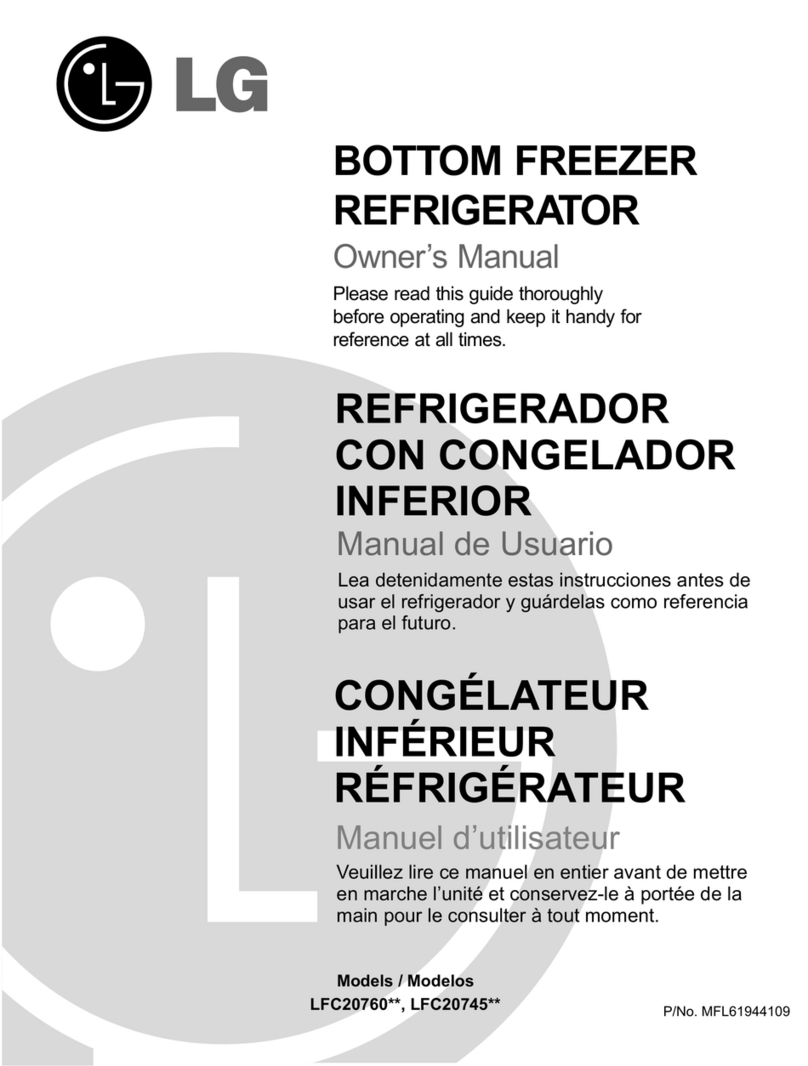
LG
LG LFC20760ST - 19.7 cu. ft. Refrigerator Manual de usuario

Sub-Zero
Sub-Zero 600 Series BI-30U Specifications

JUNO
JUNO JCT12210S5 user manual
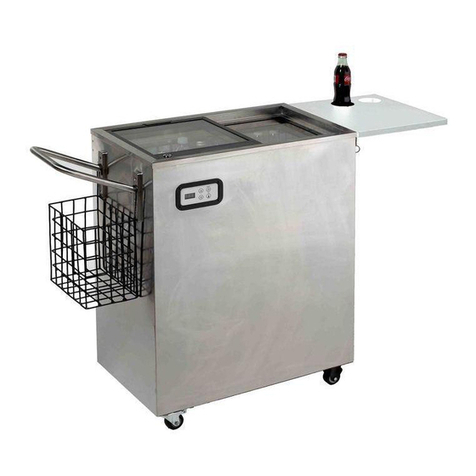
Avanti
Avanti ORC2519SS instruction manual
